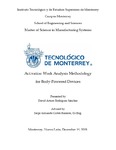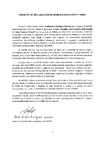| dc.contributor.advisor | Cortés Ramírez, Jorge Armando | |
| dc.creator | Rodríguez Sánchez, David Arturo | |
| dc.creator | 782312 | |
| dc.creator | 782312 | |
| dc.creator | 782312 | |
| dc.date.accessioned | 2020-03-14T01:27:08Z | |
| dc.date.available | 2020-03-14T01:27:08Z | |
| dc.date.created | 2019-12-01 | |
| dc.identifier.citation | Rodríguez, D. A.(2019). Activation Work Analysis Methodology for Body-Powered Devices. (Tesis de Maestría). Tecnológico de Monterrey, Monterrey, México. | es_MX |
| dc.identifier.uri | http://hdl.handle.net/11285/636280 | |
| dc.description.abstract | Body-powered devices have a dominant position in the market since they provide good functionality, control reliability and mechanical proprioception (the sensorial capacity to perceive one’s own limb without looking at it). In addition, they are lighter and their simple design makes them easy to repair. Body-powered mechanisms commonly consist of a cable attached to the prosthetic device from one end and to the user from the other. The cable must be pulled by either arm flexion or shoulder shrug, depending of the location where the cable is attached to the body of the user. There are two categories: Voluntary Opening (VO) and Voluntary Closing (VC). VO devices will remain closed until the user pulls the cable, while VC devices work in the opposite way. VO devices provide constant grappling once the cable is released. The force exerted to pull the cable is known as “Excursion Force”. The majority of adult users prefer VO body-powered hooks to body-powered hands, passive prosthesis and most electric devices. However, VO body-powered prostheses trade-off is their higher excursion force. Over time, users develop fatigue in their shoulders and the harness starts to irritate their skin. The current research develops an analysis methodology of the work done during the opening of the device, should be referred as “Activation Work” in order to acquire information of the distribution of the excursion force and the consequences of reducing it. The analysis is carried out in a VO body-powered device, Hosmer model 5x Hook. Overall work’s development is divided into three stages: “Characterization Method”, “Test Mechanism Design” & “Force Distribution and Activation Work Analysis”. First stage. Device is digitalized upon cable forces and excursion displacements from literature, its dimensions are unaltered to deduce the elastic constant and damping factor of its elastic band, which are used to define simulation parameters. Cable force and excursion required to open the device are calculated through simulation. Device’s activation work is deduced analytically. If analytical results coincide with experiments (literature’s measurements), then the study moves to the second stage. If not, elastic constant and damping factor deductions as well as estimations are repeated until satisfying literature’s experimental results. Second stage. Four mechanisms are tested to validate the reliability of the analysis methodology. First design, a lever perpendicular to the prosthetic limb. Second design, a lever at 60.0° from the limb. Third design comprehends two levers of different lengths, the larger one at 90.0° and the shorter one at 60.0°. Fourth design is a double pulley system with different radii. Each reducer design is modelled and simulated separately. Activation force distribution is calculated for each design. If activation work is reduced, the process moves to the third stage. If not, levers and pulleys are redesigned repeatedly until achieving activation force reduction. Third Stage. Force distribution is analyzed for each case. The virtual device reproduces literature’s excursion forces and activation work with an accuracy of 98%. Results from lever proposals demonstrates that placing a single lever at 60.0° reduces activation force the most with a percentage of 38% at full excursion displacement. Whereas the highest reduction percentage at half excursion displacement is achieved by the lever at 90.0º with a percentage of 50%. It is concluded that the methodology carried out to deduce the elastic constant and damping factor of the device’s elastic band proves to be reliable, as numerical simulation results replicate literature’s experimental measurements. It is concluded that the analysis method carried out to deduce the elastic constant and damping factor is reliable as it allows the numerical simulation to predict excursion forces and displacements with high accuracy. As both are proven when compared against literature’s measurements. Overall, the characterization method, numerical simulations and analytical deductions prove to be reliable tools for replicating literature’s experimental measurements. Allowing them to be used as validation protocols for mechanical systems. It is concluded that calculating activation work provides insight of how excursion force is distributed after a reducer is installed. For instance, the lower excursion force required is given by the single lever at 60° design; however, it reduces the force in exchange of larger excursion displacements. | es_MX |
| dc.format.medium | Texto | es_MX |
| dc.publisher | Instituto Tecnológico y de Estudios Superiores de Monterrey | esp |
| dc.relation.isFormatOf | versión publicada | es_MX |
| dc.rights | Open Access | es_MX |
| dc.rights | Attribution-NonCommercial-NoDerivatives 4.0 Internacional | * |
| dc.rights.uri | http://creativecommons.org/licenses/by-nc-nd/4.0/ | * |
| dc.subject | Ingeniería e Industria | es_MX |
| dc.subject.lcsh | Technology | es_MX |
| dc.title | Activation Work Analysis Methodology for Body-Powered Devices | es_MX |
| dc.type | Tesis de Maestría / master Thesis | es_MX |
| dc.contributor.committeemember | Hendrichs Toeglen, Nicholás Jorge | |
| dc.publisher.institution | Instituto Tecnológico y de Estudios Superiores de Monterrey | es_MX |
| dc.subject.keyword | Prosthetic Hook | es_MX |
| dc.contributor.institution | School of Engeneering and Sciences | es_MX |
| dc.contributor.institution | School of Engeneering and Sciences | es_MX |
| dc.contributor.institution | Campus Monterrey | es_MX |
| dc.description.degree | Master of Science in Manufacturing Systems | es_MX |
| dc.audience.educationlevel | Investigadores/Researchers | es_MX |
| dc.relation.impreso | 2019-12-10 | |


